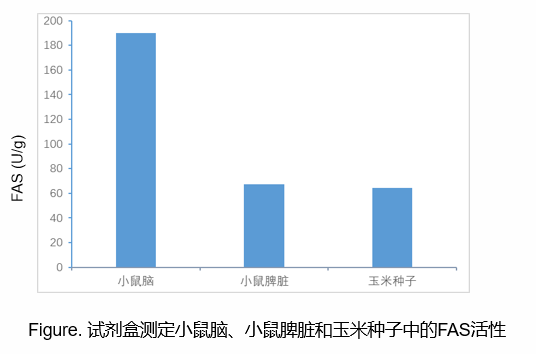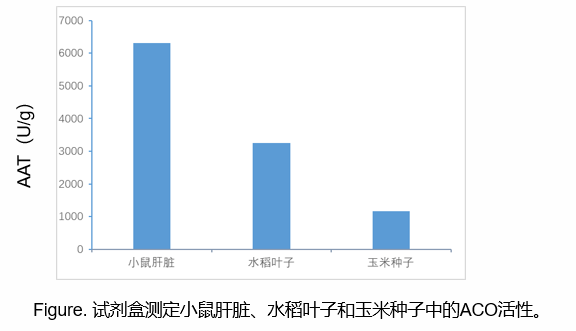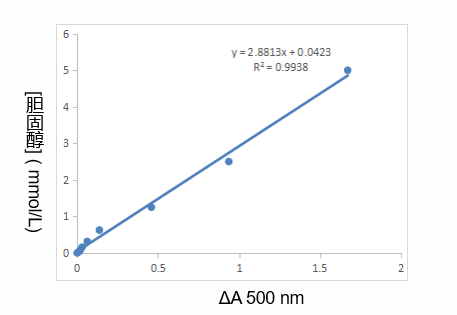2. Alcohol Acyltransferase(AAT)
Significance of AAT determination: acyltransferases (AAT) are a large family of multifunctional proteins, which are mainly responsible for catalyzing various acylation and deacylation reactions in organisms, and play an important role in gene expression, metabolism and signal transduction.
The determination principle of AAT:
AAT catalyzes acetyl CoA to transfer acetyl to butanol, while reducing DTNB to form TNB;TNB has an absorption peak at 412 nm. The increasing rate of absorbance of 412 nm is measured to calculate the AAT activity.
Test data:
Figure Determination of ACO activity in Mouse liver, Rice leaves and Maize Seeds by Kit
1. High Density Lipoprotein Cholesterol (HDL-C) Colorimetric Assay Kit
Significance of determination of high density lipoprotein (HDL-C):
High density lipoprotein (HDL) is one of the serum proteins, which is mainly synthesized by the liver, carries cholesterol in the surrounding tissue, and then is converted into bile acid or excreted directly from the intestine through bile. It is a kind of anti-atherosclerotic plasma lipoprotein and a protective factor for coronary heart disease, commonly known as “vascular scavenger”. It is an important reference index for the clinical diagnosis of coronary heart disease.
Principle of determination of high density lipoprotein (HDL-C):
The high-density lipoprotein cholesterol in serum was separated with a precipitant, and cholesterol ester was hydrolyzed by cholesterol esterase to generate free cholesterol (FC) and free fatty acid (FFA), thereby converting cholesterol ester to FC; further, cholesterol oxidase was used to catalyze the oxidation of FC. , generate △4-cholestenone and H2O2; then use peroxidase to catalyze H2O2 to oxidize 4-aminoantipyrine and phenol to generate red quinone compounds; there is a characteristic absorption peak at 500nm.
2. Low density lipoprotein (LDL-C) content detection kit
Significance of determination of low density lipoprotein (LDL-C):
Low-density lipoprotein is one of serum proteins, mainly synthesized by the liver, and is a lipoprotein particle that carries cholesterol into peripheral tissue cells. Low-density lipoprotein can enter the arterial wall cells and carry cholesterol, and can also be oxidized to oxidized low-density lipoprotein. When low density lipoprotein, especially oxidatively modified low density lipoprotein (OX-LDL) is in excess, the cholesterol it carries will accumulate on the arterial wall, and it is easy to cause arteriosclerosis for a long time. Therefore LDL is called “bad cholesterol”. Low-density lipoprotein is positively correlated with the occurrence of coronary heart disease and atherosclerotic damage, and is an important indicator for lipid disease classification and risk prediction.
Principle of determination of low density lipoprotein (LDL-C):
The low-density lipoprotein cholesterol in serum is separated with a precipitant, and cholesterol esterase is used to catalyze the hydrolysis of cholesterol ester to generate free cholesterol (FC) and free fatty acid (FFA), thereby converting cholesterol ester to FC; further use cholesterol oxidase to catalyze the oxidation of FC , generate △4-cholestenone and H2O2; then use peroxidase to catalyze H2O2 to oxidize 4-aminoantipyrine and phenol to generate red quinone compounds; there is a characteristic absorption peak at 500nm.
Test data:
Figure. Standard Curve of Cholesterol in 96-well plate assay–data provided for demonstration purposes only. A new standard Curve must be generated for each assay



